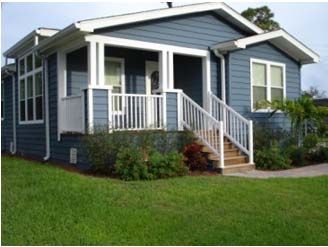Quick Facts
Manufactured Housing Overview
In the face of today’s challenging economy, the need for quality, affordable housing has never been greater. Today’s manufactured homes can deliver outstanding quality and performance at prices ranging from 30 to 40 percent less per square foot than conventional site-built homes. These savings allow more and more Americans to own their own home, even in the face of an ever-widening housing affordability gap.
The affordability of manufactured housing can be attributed directly to the efficiencies emanating from the factory-building process. The controlled construction environment and assembly line techniques remove many of the problems encountered during traditional home construction, such as poor weather, theft, vandalism, damage to building products and materials, and unskilled labor. Factory employees are trained and managed more effectively and efficiently than the system of contracted labor employed by the site-built home construction industry.
Much like other assembly line operations, manufactured homes benefit from the economies of scale resulting from purchasing large quantities of materials, products and appliances. Manufactured home builders are able to negotiate substantial savings on many components used in building a home, with these savings passed on directly to the home buyer.

Today’s manufactured homes have experienced an evolution in the types and quality of homes being offered to buyers. Technological advances allow manufactured home builders to offer a much wider variety of architectural styles and exterior finishes that will suit most any buyer’s dreams, all the while allowing the home to blend in seamlessly into most any neighborhood. Two-story and single-family attached homes are but two of the new styles being generated by factory-built innovation. As a result, today’s manufactured homes are offering real housing options for the neglected suburban and urban buyers.
At the same time, greater flexibility in the construction process allows for each home to be customized to meet a buyer’s lifestyle and needs. Interior features now include such features as vaulted ceilings and working fireplaces to state-of-the-art kitchens and baths, giving the home buyer all the features found in traditional, site-built homes. Enhanced energy efficiency in manufactured homes, achieved with upgraded levels of insulation and more efficient heating and cooling systems, provide another source of savings for homeowners, especially in this era of rising energy costs. Smart buyers are turning to EnergyStar-labeled manufactured homes for substantial savings in many aspects of owning and operating home.
Technological advances, evolutionary designs, and a focus on delivering quality homes that families can afford are the driving forces within the manufactured housing industry. That’s why more people are turning to manufactured housing to deliver homes that fit their needs and wants, at prices they can afford!
The Advantages of Manufactured Housing
Cost-Effective
- Depending on the region of the country, construction cost per square foot for a new manufactured home averages from 30 to 40 percent less than a comparable site-built home. In 2016, the average price of a new manufactured home (without land) was $70,600.
- Independent appraisal studies confirm that manufactured homes can appreciate in value the same as other forms of housing.
Built For Quality
- All aspects of the construction process are controlled.
- The weather does not interfere with construction and cause delays.
- All technicians, craftsmen and assemblers work as a team and are professionally supervised.
- Inventory is better controlled and materials are protected from theft and weather-related damage.
- All construction materials, as well as interior finishes and appliances, are purchased in volume for additional savings.
- Cost of interim construction financing is significantly reduced or eliminated.
- All aspects of construction are continually inspected by a professionally trained third-party inspector.
Amenities
- Floor plans are available that range from basic to elaborate. These include vaulted or tray ceilings, fully-equipped kitchens, walk-in closets, and bathrooms with recessed tubs and whirlpools.
- A variety of exterior siding is available, including metallic, vinyl, wood, or hardboard. In some cases, home buyers can also opt for stucco exteriors.
- Homes have pitched roofs with shingles and gabled ends.
- Design features such as bay windows are available.
- Awnings, patio covers, decks, site-built garages and permanent foundations are available as upgrades.
- The home can be customized to meet the needs of the consumer.
Safety
- The building materials in today’s manufactured home are the same as those used in site-built homes.
- The homes are engineered for wind safety and energy efficiency based on the geographic region where they are sold.
- Manufactured homes are among the safest housing choices available today due to federal laws requiring smoke detectors, escape windows, and limited combustible materials around furnaces, water heaters and kitchen ranges.
- Properly installed homes can withstand 120-130 mph 3-second gust winds in areas prone to hurricanes.
Modular Homes
Built to the same building codes as site-built homes, the modular home offers affordable quality choices in housing. New York State is traditionally in the top three states for modular home placement.
Modular homes offer the same advantages as other factory built-housing. Being built in a controlled setting, under rigorous inspection regulations, with the advantage of volume purchasing of materials, no other homes offer better value or quality.
Modular homes offer a large variety of styles of housing. Practically any home that can be designed for site building can be built in a modular setting. Today many homebuyers are using modular homes as a way of building a quality home with more square footage or amenities than their site-built budget would allow.




